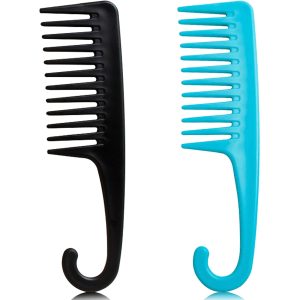Selecting the right hairbrush can significantly impact your hair care routine, especially when it comes to detangling. A quality detangling brush is essential for maintaining hair health, preventing breakage, and ensuring a smooth, manageable hairstyle. In this article, we will explore the practical benefits of detangling brushes, key features to look for, and tips for effective use to keep your hair looking its best.
Practical Benefits of Detangling Hair Brushes
Detangling hair brushes are designed to address one of the most common challenges in hair care: tangles. Tangling can occur for various reasons, including humidity, friction, and hair texture. A specialized detangling brush helps to minimize the discomfort and damage associated with traditional brushing methods.
One of the primary benefits of using a detangling brush is its ability to reduce hair breakage. Many detangling brushes feature flexible bristles that glide through the hair, separating knots without pulling or tugging. This gentler approach is particularly beneficial for individuals with long, curly, or textured hair, which is often more prone to tangling. By using a detangling brush, you can maintain the integrity of your hair, promoting stronger, healthier strands.
Additionally, detangling brushes are suitable for wet and dry hair, making them versatile tools for any hair care routine. Wet hair is more susceptible to breakage, but a quality detangling brush can safely comb through wet strands without causing damage. This versatility allows you to use the brush after washing your hair or for quick touch-ups throughout the day, ensuring your hair remains smooth and manageable.
Another significant benefit is that detangling brushes can provide a soothing experience. Many models are designed with soft bristles that massage the scalp while detangling, promoting blood circulation and enhancing overall hair health. This added comfort can transform a potentially painful experience into a relaxing one, making hair care feel less like a chore and more like a self-care ritual.
Key Features to Look For
When selecting a detangling hair brush, it is essential to consider several key features that enhance its effectiveness and usability. First, look for bristle flexibility. Brushes with flexible, rounded bristles are gentler on the hair and scalp, allowing for smoother detangling. These bristles can adapt to the contours of the head and hair type, reducing the risk of pulling and breakage.
The material of the bristles is also an important factor. Soft nylon or silicone bristles tend to be more forgiving on the hair, making them ideal for detangling. Brushes made with these materials can glide through knots more easily, providing a gentle touch that minimizes discomfort. Additionally, anti-static properties can help reduce frizz and flyaways, ensuring a sleeker finish.
Another feature to consider is the design of the brush handle. A comfortable, ergonomic handle can make a significant difference in usability, especially during longer brushing sessions. Look for brushes with non-slip grips that allow for easy maneuverability, ensuring you can detangle your hair without straining your wrist.
Finally, consider the size and shape of the brush. Larger brushes can cover more surface area, making them ideal for thick or long hair, while smaller, compact brushes are perfect for travel or for use on shorter hair. Choosing the right size will ensure that you can effectively detangle your hair without unnecessary hassle.
Tips for Effective Use of Detangling Brushes
To maximize the benefits of your detangling brush, employing the right techniques is crucial. Start by sectioning your hair into manageable parts. Working with smaller sections allows for more thorough detangling and reduces the risk of creating new tangles as you work through the hair. Begin detangling from the ends and gradually work your way up to the roots. This technique gently removes knots without causing excessive pulling.
When using a detangling brush on wet hair, consider applying a leave-in conditioner or detangling spray. These products provide additional slip and hydration, making it easier for the brush to glide through the hair. This is especially beneficial for thicker or curlier hair types, as it helps to minimize friction and prevent breakage.
Be patient during the detangling process. Rushing can lead to more tangles and potential damage. Take your time, and don’t be afraid to pause if you encounter a particularly stubborn knot. Gently working through the tangle with your fingers before using the brush can help ease the process.
Finally, incorporate regular hair care practices to maintain the health of your strands. Regularly trimming your hair, using heat protectants, and avoiding excessive styling can reduce tangling and make the detangling process easier. Healthy hair is less prone to knots, making your detangling brush even more effective.
Conclusion
Choosing the right detangling hair brush is essential for maintaining healthy, manageable hair. With benefits such as reduced breakage, versatility for wet and dry hair, and a soothing brushing experience, a quality detangling brush can transform your hair care routine. By considering key features like bristle flexibility, material, and ergonomic design, you can find the perfect brush for your hair type and needs.
Incorporating effective detangling techniques and regular hair care practices will maximize the benefits of your brush, allowing you to enjoy smooth, tangle-free hair. Embrace the power of a well-designed detangling brush, and make hair care a more enjoyable and rewarding experience. With the right tools and techniques, you can keep your hair looking its best, no matter the challenges you face.


